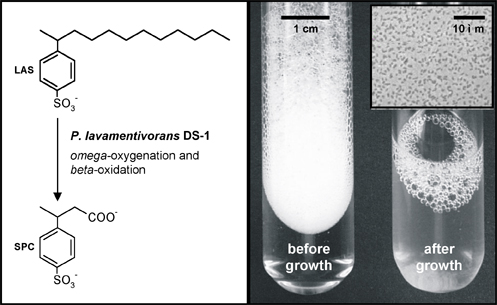Parvibaculum lavamentivorans DS-1 was isolated for its ability to degrade the commercial laundry surfactant linear alkylbenzenesulfonate (LAS) (1,2). Commercial LAS consists of a mixtures of 20 structural isomers, 18 of which are enantiomers, and more than 2 million tons of LAS are released and biodegraded every year, preferably in sewage treatments systems (3). LAS is toxic when released into aquatic environments, and its efficient biodegradation is thus crucial to prevent negative environmental impact. Strain DS-1 was enriched from a sewage treatment plant, was difficult to isolate (1), and is the first representative of a novel genus well separated from other members of the alpha-subclass of Proteobacteria (2) . Similar organisms were obtained with LAS from acclimated and pristine environments (4), and uncultivated alpha-Proteobacteria (95-97% similar in rDNA sequences) have been described from freshwater and marine environments which showed hydrocarbon degradation (5), indicating an important ecological role of this class of organisms. LAS surfactant is degraded in two tiers by bacterial communities, and Parvibaculum lavamentivorans represents the first tier (4,6) . Strain DS-1 converts LAS to a large array of short-chain sulfophenylcarboxylates (S PCs) which are excreted (6,7) , and SPCs are then utilized by second-tier organisms like Comamonas testosteroni and Delftia acidovorans (6). Strain DS-1 catalyses not only the degradation of LAS, but also of a range of 16 other anionic and non-ionic commercial surfactants (hence the species name lavamentivorans), and generates degradation intermediates thereof (2 , 8). The organism is thus an exceptional example for the first tier of many environment ally important surfactant-degrading communities. Strain DS-1 utilizes all surfactants apparently by the following biochemical strategy (2,6,8,9): the terminal alkylchain of the surfactant molecule is initially activated through omega-oxygenation. The carboxylated molecules are then funneled into a sequence of fatty-acid beta-oxidations, where C 2-units are excised from the alkylchains until the polar moieties of the surfactant molecules inhibit further reactions, and the intermediates are excreted. The nature of the many omega-oxygenase, beta-oxidation, and transport functions in strain DS-1, responsible for the uptake and degradation of the many different surfactant molecules, and for the excretion of the vast array of degradation products, are unknown. Strain DS-1 demonstrated an important role of biofilm formation in surfactant degradation (1,2,6). Growth in the presence of surfactant is strictly dependent on the availability of a solid surface in the culture fluid (e.g. polyester fleece or glass fibres), and leads to the formation of prominent biofilms attached to the solid surface . Biofilm cells are known to exhibit increased tolerance to a wide range of toxic compounds, but the role of biofilm formation of this organisms as specific response to the presence of membrane-toxic surfactant is unexplored, as well as its role as prerequisite for the complete degradation of surfactants by communities. Parvibaculum lavamentivorans DS-1 is part of a three-member model community which completely degrades individual isomers of LAS, and which forms mixed-species biofilms dependent on the presence of LAS surfactant (6). The genome sequences of the respective SPC-degrading second-tier organisms, Comamonas testosteroni KF-1 and Delftia acidovorans SPH-1, have also been established as part of the DOE-JGI Microbes 2006 Program (see JGI Project Id 4002763 and 4002762). The analysis of the three-member community genome will allow to progress our current understanding of LAS biodegradation and reveal genes and regulatory systems potentially involved in: (i) uptake and degradation of LAS, and excretion of SPC (ii) uptake and degradation of SPC, (iii) biofilm formation and surfactant resistance, (iv) horizontal gene transfer and assembly of novel biodegradative traits . The genome sequences will further build the basis for research on (v) the relationship between function and organization of the biofilm community, and (vi) of the biological responses of microbial communities to the presence of environmental stress factors.
References • Schleheck, D., W. Dong, K. Denger, E. Heinzle, and A.M. Cook. An alpha -proteobacterium converts linear alkylbenzenesulfonate surfactants into sulfophenylcarboxylates, and linear alkyldiphenyletherdisulfonate surfactants into sulfodiphenylethercarboxylates. Appl Environ Microbiol, 2000. 66 : 1911-1916. • Schleheck, D., B.J. Tindall, R. Rossello-Mora, and A.M. Cook. Parvibaculum lavamentivorans gen. nov., sp. nov., a novel heterotroph that initiates catabolism of linear alkylbenzenesulfonate . Int J Syst Evol Microbiol, 2004. 54 : 1489-1497. • Schleheck, D. (2003) Biodegradation of synthetic surfactants: linear alkylbenzenesulfonate (LAS) and related compounds . Dissertation, University of Konstanz, Germany. Download available (pdf, 3MB) at http://www.ub.uni-konstanz.de/kops/volltexte/2004/1290/ • Dong, W., P. Eichhorn, S. Radajewski, D. Schleheck, K. Denger, T.P. Knepper, J.C. Murrell, and A.M. Cook. Parvibaculum lavamentivorans converts linear alkylbenzenesulfonate surfactant to sulfophenylcarboxylates, alpha,beta -unsaturated sulfophenylcarboxylates and sulfophenyldicarboxylates, which are degraded in communities . J Appl Microbiol, 2004. 96 : 630-640. • Chang, Y.J., J.R. Stephen, A.P. Richter, A.D. Venosa, J. Brüggemann, S.J. Macnaughton, G.A. Kowalchuk, J.R. Haines, E. Kline, and D.C. White. Phylogenetic analysis of aerobic freshwater and marine enrichment cultures efficient in hydrocarbon degradation: effect of profiling method . J Microbiol Methods, 2000. 40 : 19-31. • Schleheck, D., T.P. Knepper, K. Fischer, and A.M. Cook. Mineralization of individual congeners of linear alkylbenzenesulfonate by defined pairs of heterotrophic bacteria . Appl Environ Microbiol, 2004. 70 : 4053-4063. • Schleheck D., T.P. Knepper, P. Eichhorn and A.M. Cook. Parvibaculum lavamentivorans DS-1 T degrades centrally-substituted congeners of commercial linear alkylbenzenesulfonate (LAS) to sulfophenyl carboxylates and sulfophenyl dicarboxylates. Appl Environ Microbiol, 2007 73 : 4725-4732. • Schleheck, D., M. Lechner, R. Schönenberger, M.J.-F. Suter, and A.M. Cook. Desulfonation and degradation of sulfodiphenylethercarboxylates from linear alkyldiphenyletherdisulfonate surfactants . Appl Environ Microbiol, 2003. 69 : 938-944. • Schleheck, D., and A.M. Cook. Omega -Oxygenation of the alkyl sidechain of linear alkylbenzenesulfonate (LAS) surfactant in Parvibaculum lavamentivorans T . Arch. Microbiol. 2005. 183 : 369-77. |
||
|
||
Parvibaculum lavamentivorans gen. nov. sp. nov. strain DS-1T

